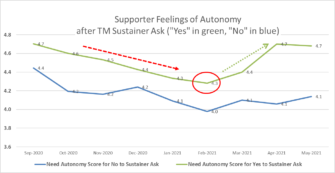Too Much of What Matters Doesn’t Get Measured At All
Does the donor experience (DE) matter to retention? If so, we probably need to deconstruct the abstract DE term.
Let’s start with context, this example is a telefundraising campaign converting digital petition leads to sustainer.
A Mental exercise: Name two parts of the call experience that have a statistically significant impact on sustainer attrition in the first 90 days.
Did your list include ask amount? And does retention go up or down as the ask amount goes up?
Ask amount matters but it’s a counter-intuitive until it isn’t. As ask amount goes up, so goes retention. Great, go big then? Not so fast. The rub is ask amount goes down during the call conditional on getting supporter “no’s” or reluctance to the starting ask. The higher amounts come from people who said yes straight away, the lower ask amounts from those who needed to be cajoled into saying yes.
But for conversation let’s assume this group of “no before saying yes” folks are still profitable. Is there a way to have our cake and eat it too or at least eat some of it?
The repeat asks can undermine feelings of autonomy and control by the human on the receiving end of that experience. Our testing shows retention going down as autonomy goes down. But what we do we do about this? If it’s just a measuring stick to nowhere then it’s not a metric worth measuring.
This is real data showing supporter feelings of autonomy after a TM sustainer conversion call tracked over time and broken out by those whose final disposition was “yes” to the sustainer ask (in green) and those who ended the call with a “no” (blue line).
Two macro take-aways.
- Feelings of autonomy impact conversion – blue line is lower than the green line. This is cause and effect. I felt like the fundraiser was undermining my sense of control and reactance kicked in, I was going to say ‘no’ over and over (if needed) to try and regain a key, psychological need.
- Something changed the green (and less so, blue) trend line and it was a positive change.
Let’s dig in on pt. 2. It wasn’t random. It was an intervention with the agency by the charity (with our guidance) to stop the negative downward trend of supporter autonomy. As it turns out, the agency had a new manager whose ethos was akin to Glengarry Glen Ross, always-be-closing.
That hurts conversion and retention. But we were able to make relatively minor re-training adjustments (down to fundraiser level which is the next level down we have for this data) to increase supporter feelings of autonomy that increased conversion and retention. Cause meet effect…

It’s cliche but true, what gets measured gets managed. But too much of what matters doesn’t get measured at all. And too much of what gets measured is done because it’s simple, easy and the way things have always been done but serving no useful, business improvement purpose.
Kevin



Hi Kevin, thank you so much for sharing this. With which strategies and in which way can we increase supporter feelings of autonomy in this kind of fundraising activity? Could you share some tips? Or, e.g., expressions that should be avoided?
Matteo, thanks for reading and your question. Here’s two items we use to measure supporter autonomy after a TM (or F2F) signup – “The fundraiser was too pushy”, “The fundraiser respected the fact it was my decision”. Both use a five-point fully labeled scale. Hopefully that gives a bit more flavor on how we want the donor to feel after the conversation.
Many scripts and trainings force the caller to make the ask 3 different times and often lowering the ask amount. there are plenty of times where it is legitimate and non-pressurizing to remake the ask based on direct (e.g., I can’t afford $20/month) or indirect (e.g. gee, I don’t know if I can swing that) feedback and other times where it’s appropriate, based on conversational cues, to use another argument to positively make the case for support. But to have it be a robotic 3 ask mantra devoid of taking conversational cues is a formula for fostering low autonomy. It is often a great idea to ask the person what they think is a monthly amount that works for them and that they’d feel comfortable and good about. The aim is not signups. The aim is signups that stick around. This seems obvious but the horrific retention data around much of the F2F world suggests it isn’t.
Beyond just the ask, if there is guilt inducing, threat language suggesting babies or puppies will die if the person doesn’t donate then autonomy is also undermined. Hope that helps.
Thank you Kevin, it’s absolutely clearer now. I think there’s a lot of material here to build up a training session for operators in the TM and F2F domain aimed to increase the feeling of autonomy in the potential donor!